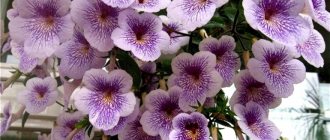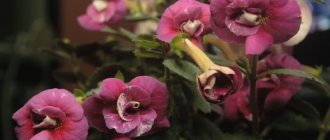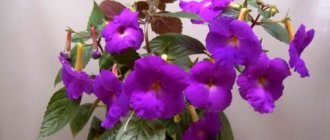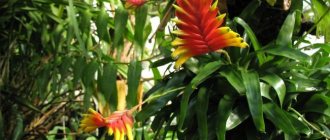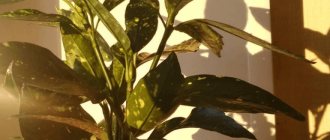It is difficult to imagine that just a couple of decades ago the number of Achimenes varieties available for growing at home was not in the hundreds, as it is today, but in dozens.
Modern lovers of flowering ornamental plants have a unique opportunity to endlessly expand their collections and enjoy new bright and unusual flowers of Achimenes. And yet everyone has their favorites. Photos and descriptions of Achimenes varieties, beloved by flower growers, will become a guide for those who are interested in this plant and want to see bushes covered with flowers on their windowsill.
Achimenes Ambroise Verschaffelt
In 1855, as a result of crossing Achimenes grandiflora var. alba and the cultivar Rinzii, Achimenes Ambroise Verschaffelt was obtained, named after one of Belgium's outstanding gardeners, Ambrose Verschaffelt.
The Achimenes variety that was bred at that time turned out to have a long, happy life. Erect bushes with brownish stems and green foliage are decorated with large flowers. Each corolla bears an openwork network of purple veins, and its center is marked with a bright yellow spot.
Varieties
Achimenes Yellow English Rose flowers are especially popular among gardeners. Today, breeders have developed a huge number of varieties that differ from each other in the color of not only flowers, but also leaves. Also, the types of Achimenes differ from each other in the type of shoot. Thus they can be erect and ampelous. The advantage of these beautifully flowering plants is that they are relatively easy to care for. With proper flowering, such tropical perennials will delight you with their bright flowers for a long time and abundantly.
Varietal diversity
In addition to the natural species of this extraordinary flower, there are also a huge number of varieties bred by breeders. They used wild varieties of Achimenea, and as a result of hybridization, numerous beautiful varieties appeared, distinguished by large inflorescence sizes, unusual appearance, and even colors that are not found in natural growth.
Achimenes Double Picotee Rose
The plant was bred by G.Mossop, is distinguished by its stable flowering and the fact that, according to the description of Achimenes, the medium-sized flowers stably maintain a bizarre shape. The Double Picotee Rose variety is Achimenes, representing a spectacular family of plants with double flowers reminiscent of a rose. The corollas are white, terry, with thin, barely noticeable lilac tones and veins, which become brighter closer to the throat, giving the flower volume and additional attractiveness. The Achimenes bush, as in the photo, is compact, with bright green foliage and pinkish-brown stems. The same shades are present on the back of the leaves.
Description
Achimenes is native to the American continents. Since the end of the 18th century, the plant was brought to Europe from the Caribbean islands. In the 19th century, the flower was actively selected, and by the beginning of the 20th century many hybrids had appeared. Nowadays, agronomists continue to work on developing new varieties, the Romanian scientist Serge Saliba was especially successful, who bred about 200 species of this beautiful plant.
Achimenes are perennial flowers of the Gesnerieceae family, with thin drooping stems, some varieties have an erect stem. For example, the only species that does not grow in America, but in South India, is endowed with just such a stem. The leaves are pubescent, with a rich color at the bottom. Single and paired inflorescences are fixed in a thin five-leaf calyx.
Achimenes suspend their vital activity, freezing from mid-autumn to early spring (for 4-6 months), when daylight hours become short. In this case, the ground part completely dies off. They reproduce by rhizomes, which are small scaly shoots that resemble very young fir cones. The plant does not have underground tubers, and rhizomes, appearing on the rhizome, play the role of seeds in the reproduction process. From late winter to mid-spring, young shoots appear, the first harbingers of “awakening”.
Achimenes Stan's Delight
Achimenes Stan's Delight bred by G.Mossop can be called one of the oldest terry varieties, since it appeared in 1993 or 1994. Achimenes flowers are distinguished by their densely double shape and carmine or crimson-red coloring of the corollas. At the throat, under the central petals, you can see a yellow spot with dotted burgundy or brownish specks. The edges of the petals are rounded-toothed, which only complements the decorative effect of this Achimenes variety. This plant is characterized by the formation of erect shoots with dark green foliage, on the reverse side having a distinct purple tint.
Diseases and pests
The frequency and nature of plant diseases depend on how to care for the Achimenes flower. If the conditions and rules of agricultural technology are not violated, there may not be problems with cultivation. Among the most common diseases are the following:
- When watering with hard water, chlorosis appears. The leaf blade begins to turn yellow.
- Ring spotting is quite common. It appears as light round spots on the foliage of the plant, which turn brown a little later. This is a non-communicable disease. Occurs when watering with cold water, drafts or excessive sunlight.
If we talk about infectious diseases of Achimenes, fungal infections are the most common. Browning and dying of leaves with the formation of a gray coating on them is a clear indicator of gray rot. Its development is promoted by excessive air humidity and low temperature. To combat such damage, fungicides are used, and damaged plant elements are plucked off.
The plant can also be affected by red spider mites. To destroy pests, double spraying with acarcides is used. Insecticides are used to control thrips.
Always inspect acquired adult Achimenes or planting material for contamination. If necessary, treat it with the necessary products and quarantine it away from indoor plants.
Achimenes Purple King
The patriarch among popular varieties can be called Achimenes Purple King, bred by Park back in 1936. The plant can also be found under another name. A synonym for this Achimenes variety is the name Royal Purple. This famous variety is characterized by large purplish-violet flowers with fringed petals and a prominent pattern of darker veins.
At the entrance to the pharynx, the corolla has a yellow spot with dark brown speckles. Young shoots are erect, but then, as in the photo of Achimenes, they take on a drooping or semi-ampeloid shape. The leaves of this variety of Achimenes are dark green with a purplish tint at the base and a serrated edge.
Reproduction
Achimenes reproduces in three ways:
- rhizomes;
- cuttings;
- seeds.
Rhizomes
The easiest and fastest way to propagate Achimenes is by dividing its rhizomes. The root system of the plant consists of rhizomes, which in appearance resemble a small cone or mulberry. Large rhizomes are divided in such a way that each component has at least one shoot.
After treating the rhizomes in a solution of potassium permanganate, the shoots are planted in loose soil, and two months after planting, they begin to regularly apply fertilizers. Closer to autumn, it is necessary to fertilize with potassium in order for large tubers to grow.
From one rhizome it is not at all difficult to grow a gorgeous flowering achimenes. We remove the crown of the emerging sprout with nail scissors so that the plant does not tend to grow into one stem and forms a fluffy bush.
We plant the top of the head in the same pot, pressing it slightly to the ground, cover it with cling film, and make small holes in it for air exchange.
We send the pot under lighting. A greenhouse effect is formed under the film, which contributes to the rapid rooting of the pincer crown.
When the cutting takes root, we remove the film, but it’s still a little early to tweezing and pinching. A little later, we’ll cut off the tops of both sprouts and plant them in the same pot.
How to grow Achimenes from a rhizome, watch the video:
Cuttings
It is possible to propagate Achimenes using cuttings, but professionals consider this method unsuccessful for the plant. The rhizomes will not have time to fully form before the cold snaps; small rhizomes will disappear in the winter. Without a dormant period, the plant will not bloom in the spring.
A popular option for propagating rare species. A cutting of at least 5 cm in length is cut from the tops. The lower leaves are removed and placed in warm water with the addition of charcoal powder. In the light, the roots will appear after about 10 days. The rooted cuttings are planted in the ground. Can be propagated by leaf cuttings. The leaf is placed in moistened soil and covered with film. When the roots appear, they are planted in a separate pot. After a few months, the pot is changed to a larger one.
It is enough to put the apical cuttings in water and keep them warm. Cuttings take root quite quickly.
Propagation by leaf cuttings, mainly when breeding varieties with variegated leaves. The most unreliable method at home. Requires a warm substrate and high humidity. In such conditions, all sorts of pathogens will quickly appear, and ideally healthy leaves will be selected.
Experts advise lighting and fertilizing the plant with root growth stimulants, delaying the dormant period and making it short.
Advice! Remove the emerging buds from the rooted cuttings. They will slow down the growth of the plant, and it will be weak and frail. Allow it to bloom after the bush has grown lush and strong.
Seeds
You can buy seeds at a flower shop or, if you already have achimenes at home, get them from there.
To do this, you first need to artificially pollinate the flowering achimenes. After pollination, small fruits will appear on the plant, which will ripen after a few months.
Their softness will indicate the ripeness of the fruit. The seeds are collected and stored during the winter. In February they are sown in coarse sand or leaf soil mixture. Achimenes seeds do not need to be deeply immersed in the substrate and should not even be sprinkled with a thin layer on top. To germinate seeds, choose transparent containers with a lid.
Crops germinate well if the room temperature is maintained at a constant temperature of 22–24 °C. The container with grains must be regularly sprayed, watered and ventilated. After a few weeks, the first shoots will appear.
The plant must be pruned as soon as the first two leaves appear: cut the central root by one third and replant it in a more nutritious substrate. Diving allows you to form a more branched root system.
A serious disadvantage of growing Achimenes from seeds is that this method does not transmit the varietal characteristics of the parent flower. There is also a long wait for flowering: Achimenes will delight you with flowers only in the second year.
Planting and replanting Achimenes at home with video
After a successful wintering, the grown Achimenes is transplanted every spring.
When should you plant Achimenes rhizomes after wintering? Planting dates begin at the end of February and continue until the end of March. This procedure requires care on the part of the grower.
- After the end of the dormant period, the rhizomes are carefully removed from the pot.
- It is necessary to free the roots from adhering soil so that bare rhizomes remain. If they have acquired a dark brown color, this means that the plant is aging and drying out.
- It is necessary to carefully examine the bare rhizomes to see if there is excess mold on them.
- If mold has formed on the scales, then treatment with a fungicide is needed. Only after this can the plant be replanted. The rotted rhizome is thrown away.
To transplant homemade achimenes, you can use a ready-made mixture for cyclamens ; it must be diluted with sifted sand. Drainage must be poured into the bottom of the pot, sprinkled with soil and a layer of sand. The tubers are placed directly on it and sprinkled with a good layer of fertile soil. After this, the transplanted achimenes is watered.
Under no circumstances should you plant several varieties of this plant in one pot. They have different vegetation intensities, so strong brothers can suppress weaker varieties. For achympenes, you need to use wide pots with shallow depth.
Blooming achimenes cannot be replanted . If you purchased new seedlings without flowers, just waking up after wintering, it is quite possible to successfully replant them immediately after purchase.
Peculiarities
Achimenes belongs to the genus of flowering plants from the Gesneriev family. This is a perennial rhizomatous herbaceous plant that blooms in beautiful multi-colored inflorescences. This flower is considered a relative of gloxinia and violet. It is characterized by brightness and abundance of flowering.
The root system is a rhizome in the form of rhizomes, covered with scales and very reminiscent of birch catkins or spruce cones. The flower has weak stems and weakly branching shoots, covered with a dark green shell, sometimes with a reddish tint. Stems can grow vertically or droop and spread.
Achimenes is distinguished by the duration of its flowering - it begins in May and ends only in October. Inflorescences with 5 petals can be single or paired and are characterized by a variety of colors and shades.
The outer surface of the leaves is smooth and shiny, with prominent veins. Their color can be rich green, pinkish and even crimson. The inner side is slightly pubescent. The leaves have an oblong shape, the edges are wavy and finely toothed.
The genus of this flower is distinguished by many species (about 26), varieties and bred hybrids. Achimenes are divided into main types according to the following characteristic features.
- Type of growth of stem and shoots. Achimenes are divided into straight-growing, semi-ampelous and ampelous. In upright-growing achimenes, the stem grows vertically, and the side shoots grow to the sides, forming a bush. Ampelous plant species have a flexible stem that is lowered down and creeping shoots. In semi-ampelous Achimenes, climbing shoots require a direction of growth.
- Plant size. The height of the flower can vary between 25-50 cm.
- Type of inflorescences. Flowers are simple with smooth petals, semi-double or fully double.
- The size of the inflorescences. Achimenes flowers can be small (2.5-3 cm), medium (3-4.5 cm) and large - up to 6 cm in diameter.
- Color color of inflorescences. The color scheme is represented by almost the entire palette of shades: white, various shades of red - from pink to burgundy, purple and blue, yellow and orange. Based on color, two species are particularly distinguished - candida (white) and coccinea (bright red or purplish-red shades).
- Bud shape. They come in round, elongated or bell-shaped shapes.
A special place in species diversity is occupied by the Mexican species and Achimenes Erinberg. A distinctive feature of the first is the color of its leaves. On the outside they have a rich green color, and the inner surface is a beetroot shade. The color of the inflorescences is purple.
Ehrenberg's species is atypical for the genus Achimenes. Lettuce leaves are egg-shaped with very thick pile (like cotton wool) on the inner surface. The bell-shaped inflorescences are painted in pale lilac tones.
Bloom
Known species come from areas from Mexico to Brazil. Hybrids range in height from 20 to 35 cm, species are slightly taller. Jimenez Double Pink Rose blooms from mid-June until October. Flowers, white, blue, pink, purple, red and almost all shades of the listed colors. The least genetically resistant varieties have yellowish flowers.
Prefers a brightly lit place, without direct sunlight. The intensity of the pink color depends on this.
When growing in containers placed outside, a good location is where tuberous begonias have previously grown well.
